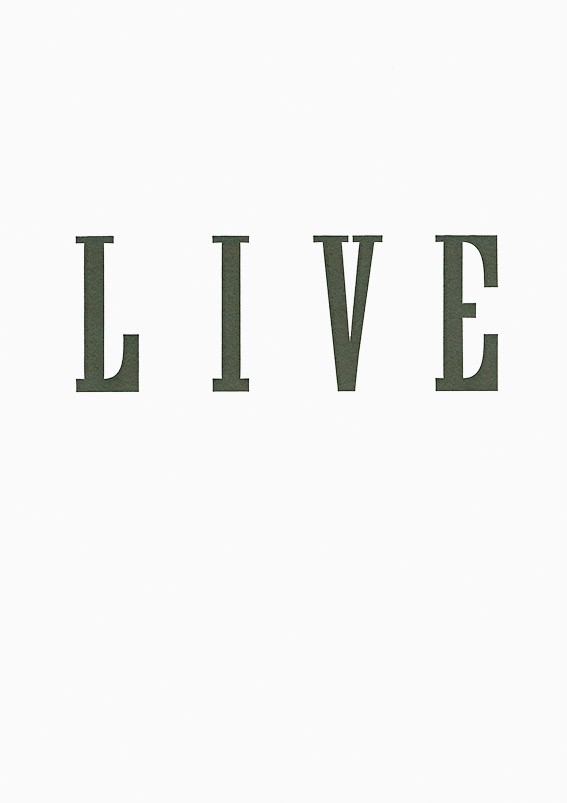“Live” by Janice Kerbel
Janice Kerbel’s wide-ranging practice—from typographic posters to choreographed performances of synchronized swimming—can be divided into two broad bodies of work: those to be read, and those to be seen or heard, typically through live performance. LIVE, a new publication of three scripts and a score written by Kerbel over the past ten years, provides the textual counterparts to four of her major performed works. Kerbel, a Canadian artist who has lived and worked in London for the past two decades, is meticulous in the preparation and research for her artworks from her earliest project after graduating with an MA from Goldsmiths College in 1995. Soon after, she made Bank Job, 1999 (not included in LIVE), wherein she posed as an architecture student for a year and a half to prepare the detailed plans for a bank heist in the Lombard Street branch of the London private bank Coutts and Co. The heist never happened, it existed then and exists now only in its plan, and in book form as 15 Lombard St. But most of Kerbel’s heavily researched works produced thereafter have gone on to have a form beyond their texts. LIVE is a document of these works as texts, which together probe the limits of written language as it translates an idea to audio or visual form.

Live, by Janice Kerbel, co-published by Art Museum, University of Toronto; Badischer Kunstverein, Karlsruhe, Germany; The Polygon Gallery, Vancouver; and Occasional papers, 2018.
The first piece is Nick Silver Can’t Sleep, 2006, a radio play commissioned by independent arts producer Artangel and broadcast on BBC Radio3’s The Verb (a late-night show on new poetry and performance on the station, which normally features classical music). It tells the nocturnal story of ill-fated love between two plants that bloom at non-overlapping times, destined by nocturnal rhythms and botany never to meet. Kerbel developed the research in dialogue with insomniacs and botanists, and the script, as odd as the subject appears to be, is the most straightforward one in LIVE. Another script is Ballgame, 2009, which I first heard as Pre-game, read aloud in a 2009 presentation by BookWorks held at Toynbee Studios in East London, where I worked at the time. The then work-in-progress was read by actor David Thorpe. In its final form, Ballgame is shown as a sound installation, with one black mounted speaker positioned in the gallery, through which plays the announcement of a fictional baseball game. It is based on mathematical averages that Kerbel researched and then produced statistically, typical of most ball games. In both works, Kerbel hints at an unrealized potential that exists only in language. (This is a recurring theme in Kerbel’s practice: a commission for Frieze Art Fair in 2008, Remarkable, was a series of silk-screened posters for imagined, fantastical Victorian sideshows.)
The latter two works in LIVE further push the tension between language and the forms it prescribes, scripts or choreographs. Doug, 2015 (a musical composition of nine songs for six voices), and Kill the Workers!, 2011 (a play carried out entirely through lighting cues), both establish greater distance in the work from what an art gallery audience would see or hear, and what the reader on the page encounters. Doug, which was commissioned by the Common Guild in Glasgow, and for which Kerbel was nominated for the Turner Prize, required that Kerbel study musical composition, which she did with Phillip Venables and Laurie Bamon. In each of the songs, the protagonist meets an untimely death—by bear attack, by fall, by choking. Within this narrative parameter, Kerbel writes nine songs that reflect, both musically and lyrically, the protagonist’s death. In Choke, the victim’s larynx tightens around the caught food, so we read (or indeed, could sing): “Fle-shy fun-gal frui-ty spores meet ba-sic hu-man need. Sweet and so-ur suc-cu-lence heads reck-less-ly to greed.” The reader can feel the restriction of breath and shortening of time that comes with choking, in the staccato tempo and use of increasing melisma, and can imagine the choral performance the text prescribes. The lyrics are printed in full in the appendix, and Kerbel is a good poet. The scansion of the lyrics, the highly visual depiction, make these eccentric songs stand as poems in their own right. But Kerbel is not interested in words on the page, but rather in what words do, how they can exist both here and there, in the site and non-site of the page, to paraphrase Robert Smithson. Kill the Workers! diverges most in the distance between the gallery installation and its script. The script gives a different insight to the piece’s production and choreographing from what the audience, who are mobile and unseated, might encounter in a gallery, where the piece runs roughly 24 minutes. It is the unspoken logic of theatre, music, encounters, even synchronized swimming to which Kerbel returns. Rather than asking what forms a script could prescribe, Kerbel returns, repeatedly, to the question: What scripts, notations or typographical forms might a performed event require?
LIVE, by Janice Kerbel, 2018, co-published by Art Museum, University of Toronto; Badischer Kunstverein, Karlsruhe, Germany; The Polygon Gallery, Vancouver; and Occasional Papers, 120 pages, paperback, $20.00.
After 15 years in London, Kim Dhillon now writes about art from Vancouver Island. She teaches critical theory at the University of Victoria.

